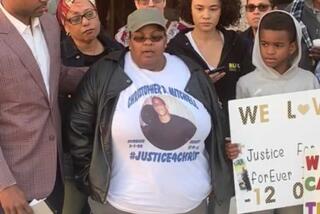Mistrial declared in white police chief’s fatal shooting of black man
- Share via
A jury in South Carolina couldn’t decide whether to convict a white former police chief who fatally shot an unarmed black man in a case that was viewed as more about the perils of small-town policing than the racial divide that has marked many other recent police shootings across the country.
An Orangeburg County jury deliberated for about 12 hours ending after midnight early Tuesday when a judge accepted that it was deadlocked over the fate of former Eutawville Police Chief Richard Combs in the shooting of Bernard Bailey in May 2011. Jurors split, 9 to 3, officials said, but it was not known how many supported a conviction for murder, a lesser charge or wanted the chief acquitted.
According to officials, prosecutors will decide whether to retry the case. Bailey’s relatives said they would continue to seek a conviction.
“We are not dissuaded from our unswerving pursuit of justice for Bernard Bailey,” the family said in a statement. They also thanked jurors “even though the jury was deadlocked and a mistrial was declared.”
The shooting is among a series of deaths of unarmed black men at the hands of white police nationwide in recent years. Grand juries in Ferguson, Mo., and New York’s Staten Island decided not to charge white officers involved in the deaths last year of Michael Brown and Eric Garner, respectively. Both cases sparked demonstrations protesting police actions.
The trial of Combs, who was police chief in a county with a large African American population, has not carried the same type of racial overtones as did the other cases. Instead, it has raised questions about the problems associated with policing in small towns.
“It was a stupid tragedy — nothing to do with black or white,” Cynthia Nutt, the white owner of C&J Trading Post in the town, said of the confrontation between Combs and Bailey.
“He went up to plead his daughter’s case and he ended up dead,” she said of Bailey. “How did it escalate to that?”
Bailey went to Town Hall on May 2, 2011, to discuss his daughter’s traffic ticket for a broken taillight. Within minutes, he was dead — the police chief shot him twice in the chest. A third bullet passed through Bailey’s shoulder and into his head.
News of the shooting swiftly spread through Eutawville, a tightknit town with a population of barely more than 300. Nearly everyone said they knew Bailey, a 54-year-old father of five. He was the deacon of a Baptist church, his wife the elementary school librarian.
“People were just, like, ‘Bernard? Really?’” said Stacie Shuler, owner of Chic Salon & Makeup, a block from Town Hall. “He was the last man anyone would have expected to die that way. It didn’t make sense.”
More than three years after the shooting, a grand jury indicted Combs on murder charges. The news was announced on the same day that a grand jury in New York declined to charge a white police officer in the choking death of Garner.
Throughout Eutawville, which is 36% black, there was shared relief at the former police chief’s indictment.
“He was a black man,” said Adam Green, the black owner of the Hair Doctor barber shop, describing Bailey as a close friend, fellow church member and a pillar of the community. “It would never have happened to a white man.”
The Bailey family has pointedly distanced its case from the high-profile police shootings in New York and Missouri. “That is comparing apples and oranges,” Bailey’s widow, Doris Anderson Bailey, told reporters.
According to testimony at the trial, Combs first met Bailey nearly four years ago when Combs stopped Bailey’s daughter for a traffic violation. Bailey arrived at the scene when his daughter called him.
Combs and Bailey had a tense exchange, according to media reports from the courtroom. Bailey was not arrested that night, but Combs got a warrant charging Bailey with obstruction of justice.
About seven weeks later, Bailey went to Town Hall to talk about his daughter’s ticket. Combs refused to discuss the case because Bailey was not the driver, but he did tell Bailey about the outstanding warrant.
Combs testified during his trial that Bailey became “very angry and very irate” before he rushed out to the parking lot to his Chevrolet Silverado. When they were outside, Combs said, “he stood up straight and clenched his fists and clenched his teeth together and said, ‘Don’t put your hands on me.’”
Combs testified that Bailey shoved him. The police chief said he tried to handcuff the larger man. Bailey started the truck’s engine and put the vehicle into reverse, striking “the whole left side of my body,” Combs said.
“I thought I was going to die,” he said. “I thought I was going to be run over by the truck.”
Then, Combs said, he opened fire.
Twitter: @latimesmuskal
Muskal is a Times staff writer, and Jarvie is a special correspondent.
More to Read
Sign up for Essential California
The most important California stories and recommendations in your inbox every morning.
You may occasionally receive promotional content from the Los Angeles Times.











